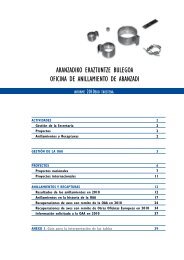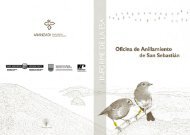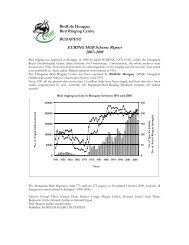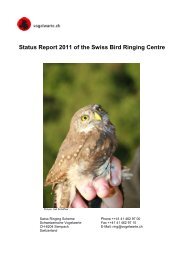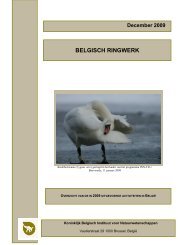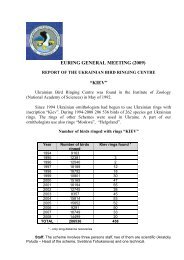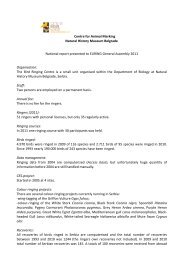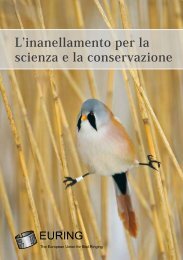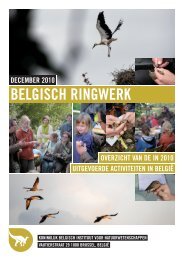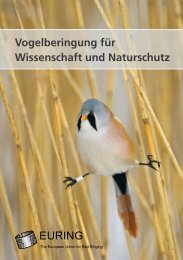The quantitative study of marked individuals in ecology, evolution ...
The quantitative study of marked individuals in ecology, evolution ...
The quantitative study of marked individuals in ecology, evolution ...
Create successful ePaper yourself
Turn your PDF publications into a flip-book with our unique Google optimized e-Paper software.
EURING 2003 Radolfzell<br />
grow<strong>in</strong>g population has been performed over the last 20 years throughout the country<br />
by many volunteers. Us<strong>in</strong>g this large-scale and long-term r<strong>in</strong>g<strong>in</strong>g and resight<strong>in</strong>g data<br />
set, we constructed capture-recapture models to <strong>in</strong>vestigate the variation <strong>of</strong> lifehistory<br />
traits underly<strong>in</strong>g the dynamics <strong>of</strong> this population, and the consequences <strong>of</strong> the<br />
re<strong>in</strong>troduction program on these traits.<br />
In a first step, we fully describe the effects <strong>of</strong> age, time, cohort and trap-dependence<br />
on White stork survival and resight<strong>in</strong>g rates, thus provid<strong>in</strong>g precise estimates <strong>of</strong> these<br />
traits. A gradual <strong>in</strong>crease <strong>in</strong> both survival and resight<strong>in</strong>g rates with age is described<br />
for the first time <strong>in</strong> this long-lived species. Interest<strong>in</strong>gly, survival rate decreases with<br />
time, parallel<strong>in</strong>g the <strong>in</strong>crease <strong>in</strong> the proportion <strong>of</strong> free-fly<strong>in</strong>g <strong><strong>in</strong>dividuals</strong> <strong>in</strong> the population.<br />
<strong>The</strong>se results also allow us to account for time and age effects <strong>in</strong> <strong>in</strong>vestigat<strong>in</strong>g<br />
the consequences <strong>of</strong> supplementary feed<strong>in</strong>g on life-history traits, while keep<strong>in</strong>g capture-recapture<br />
models tractable <strong>in</strong> these further analyses.<br />
<strong>The</strong> exact causes <strong>of</strong> the White Stork population decl<strong>in</strong>e were not clear, but mortality<br />
on migration is thought to have <strong>in</strong>creased (exacerbated by the proliferation <strong>of</strong> highvoltage<br />
power l<strong>in</strong>es across Europe). Adverse weather on the w<strong>in</strong>ter<strong>in</strong>g grounds could<br />
also have depressed survival. Supplementary feed<strong>in</strong>g may then have ameliorated<br />
survival either by giv<strong>in</strong>g the birds a better body condition prior to migration, or by encourag<strong>in</strong>g<br />
them to stay beh<strong>in</strong>d, surviv<strong>in</strong>g the European w<strong>in</strong>ter on artificial food supplements.<br />
In a second step, we thus used detailed data on the location <strong>of</strong> breed<strong>in</strong>g<br />
attempts with respect to the food sources over the country (food was provided at the<br />
breed<strong>in</strong>g stations) to assess the consequences <strong>of</strong> supplementary feed<strong>in</strong>g on survival,<br />
resight<strong>in</strong>g rate and migratory behaviour. More specifically, we <strong>in</strong>vestigate whether<br />
survival rate to the next year, resight<strong>in</strong>g rate and migrat<strong>in</strong>g probability depend on food<br />
availability dur<strong>in</strong>g the breed<strong>in</strong>g season. Food availability was considered to decrease<br />
with <strong>in</strong>creas<strong>in</strong>g distance from the nest to the nearest breed<strong>in</strong>g station. Further, we<br />
analyse potential differences <strong>in</strong> survival rate accord<strong>in</strong>g to <strong>in</strong>dividual migratory status<br />
(i.e. migratory vs. resident <strong><strong>in</strong>dividuals</strong>). This status is def<strong>in</strong>ed us<strong>in</strong>g resight<strong>in</strong>g data<br />
collected all over Europe and Africa. Prelim<strong>in</strong>ary analyses suggest that survival does<br />
not differ accord<strong>in</strong>g to food availability, but the probability <strong>of</strong> migrat<strong>in</strong>g decreases with<br />
<strong>in</strong>creas<strong>in</strong>g food availability.<br />
Overall, our results emphasize the importance <strong>of</strong> the large scale population monitor<strong>in</strong>g<br />
<strong>in</strong> obta<strong>in</strong><strong>in</strong>g life-history trait estimates that will prove useful for managers to make<br />
efficient decisions for future strategies <strong>of</strong> conservation for the White stork <strong>in</strong> the<br />
Netherlands. Build<strong>in</strong>g an <strong>in</strong>tegrated demographic population model with the precise<br />
estimates obta<strong>in</strong>ed via our analyses, based on data collected at large spatial scales,<br />
will <strong>in</strong>deed eventually allow reliable predictions on the long-term population dynamics<br />
to be made under different conservation scenarios.<br />
02:20 PM - 02:45 PM<br />
Estimat<strong>in</strong>g correlates <strong>of</strong> survival rates from nationally coord<strong>in</strong>ated r<strong>in</strong>g<strong>in</strong>g data on<br />
owls <strong>in</strong> F<strong>in</strong>land<br />
Pertti Saurola & Charles Francis<br />
S<strong>in</strong>ce 1974, bird r<strong>in</strong>gers <strong>in</strong> F<strong>in</strong>land have been encouraged to r<strong>in</strong>g both nestl<strong>in</strong>gs and<br />
adults <strong>of</strong> many species <strong>of</strong> birds <strong>of</strong> prey, especially owls. This coord<strong>in</strong>ated effort, <strong>in</strong>volv<strong>in</strong>g<br />
several hundred r<strong>in</strong>gers, now results <strong>in</strong> more than 30,000 potential nest sites for<br />
owls be<strong>in</strong>g checked annually, and has led to over 200,000 owls be<strong>in</strong>g r<strong>in</strong>ged <strong>in</strong> F<strong>in</strong>land<br />
up until 2002. Many <strong>of</strong> these owls are subsequently recaptured as breed<strong>in</strong>g<br />
adults, by the same or different r<strong>in</strong>gers, while others are recovered dead by the general<br />
public. All <strong>of</strong> the r<strong>in</strong>g<strong>in</strong>g and encounter data, as well as many biometric data are<br />
centrally computerized, allow<strong>in</strong>g for large-scale analyses <strong>of</strong> geographic and temporal<br />
33



